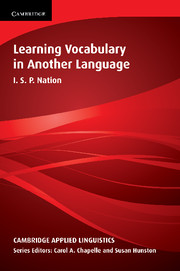
-
Select format
-
- Publisher:
- Cambridge University Press
- Publication date:
- October 2012
- March 2001
- ISBN:
- 9781139524759
- 9780521804981
- Dimensions:
- Weight & Pages:
- Dimensions:
- (228 x 155 mm)
- Weight & Pages:
- 0.786kg, 492 Pages
- Series:
- Cambridge Applied Linguistics
You may already have access via personal or institutional login- Series:
- Cambridge Applied Linguistics
Book description
Learning Vocabulary in Another Language provides a detailed survey of research and theory on the teaching and learning of vocabulary with the aim of providing pedagogical suggestions for both teachers and learners. It contains descriptions of numerous vocabulary learning strategies which are justified and supported by reference to experimental research, case studies, and teaching experience. It also describes what vocabulary learners need to know to be effective language users. Learning Vocabulary in Another Language shows that by taking a systematic approach to vocabulary learning, teachers can make the best use of class time and help learners get the best return for their learning effort. It will quickly establish itself as the point of reference for future vocabulary work.
Reviews
'Provides a clear survey of the current state of research and offers practical teaching techniques. The book enables the teacher to be an informed practitioner. Verdict: **** a valuable book for diploma students.'British Council Network News
'Nation takes his 477 pages well, taking a truly useful approach to linking research to practice by providing teachers with concrete ideas with which to help learners build their second language vocabulary. I highly recommend this book to anyone looking to include a clear vocabulary thread in their teaching, and to teacher educators who have an influence on the methodology and approaches of future teachers.'ELT Journal
'Paul Nation's Learning Vocabulary in Another Language provides the most comprehensive review of research and theory on teaching and learning vocabulary, and remains the essential reference on vocabulary. … [It] is the essential text for anyone interested in research on vocabulary. It was written with an audience of second and foreign language teachers in mind. … Nation skilfully applies experimental findings to the teaching and learning of vocabulary. [His book] has established itself as the key reference work for scholars who are interested in vocabulary and is likely to remain the point of reference for future work on vocabulary for some time.'Language Teaching
Contents
Metrics
Altmetric attention score
Full text views
Full text views help Loading metrics...
Loading metrics...
* Views captured on Cambridge Core between #date#. This data will be updated every 24 hours.
Usage data cannot currently be displayed.
Accessibility standard: Unknown
Why this information is here
This section outlines the accessibility features of this content - including support for screen readers, full keyboard navigation and high-contrast display options. This may not be relevant for you.
Accessibility Information
Accessibility compliance for the PDF of this book is currently unknown and may be updated in the future.


